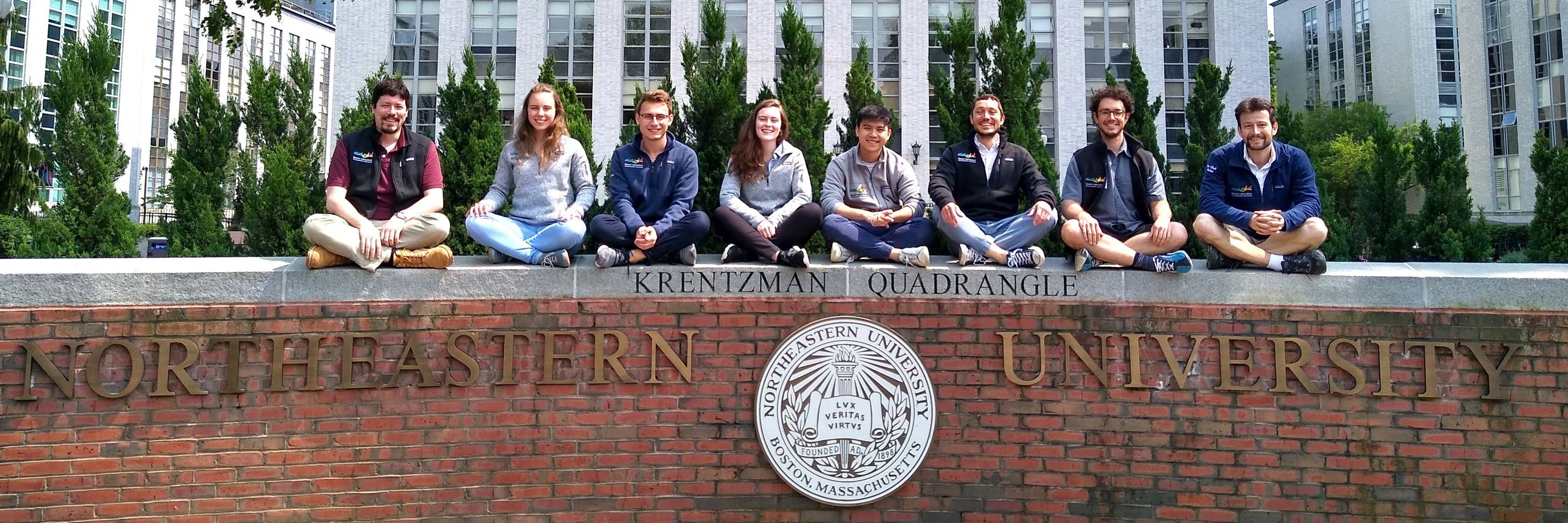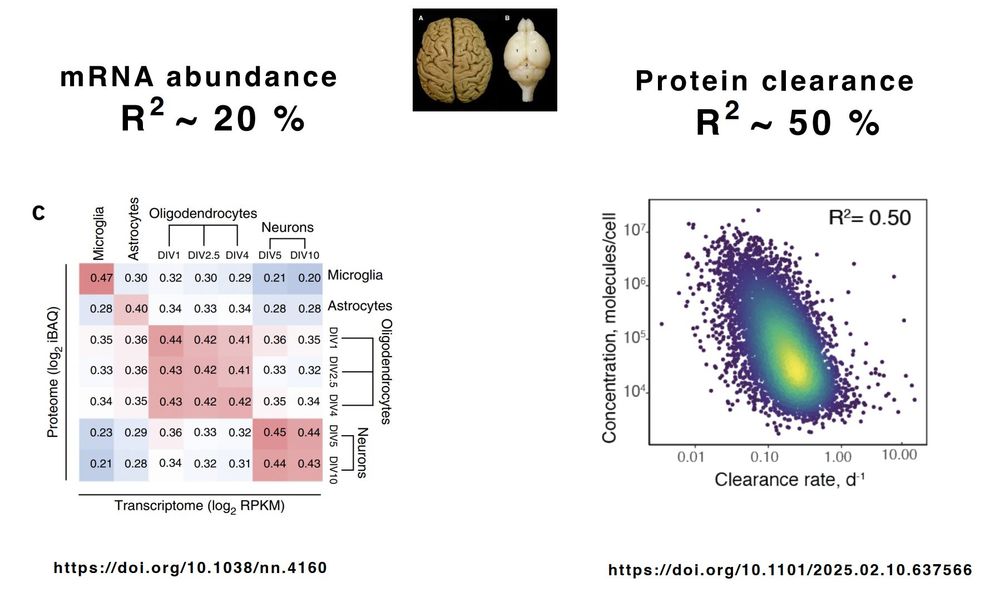
https://nikolai.slavovlab.net

⬛️ Their abundance strongly declines in AD patients.
=> This decline parallels a reduction in 20S substrate proteins and leads to abnormal protein accumulation in AD.
www.biorxiv.org/content/10.1...

⬛️ Their abundance strongly declines in AD patients.
=> This decline parallels a reduction in 20S substrate proteins and leads to abnormal protein accumulation in AD.
www.biorxiv.org/content/10.1...
The brain proteome is highly sculpted by protein degradation.
Why ?
This is our model: biorxiv.org/content/10.1...

The brain proteome is highly sculpted by protein degradation.
Why ?
This is our model: biorxiv.org/content/10.1...
In the absence of obvious physical sensing organs like lenses, how do plants work out the precise direction from which light is coming ?
In the absence of obvious physical sensing organs like lenses, how do plants work out the precise direction from which light is coming ?
Yet, studies show there’s only so much protein the body can use.

Yet, studies show there’s only so much protein the body can use.
𝐓𝐡𝐞 𝐬𝐢𝐦𝐩𝐥𝐞𝐬𝐭 𝐞𝐱𝐩𝐥𝐚𝐧𝐚𝐭𝐢𝐨𝐧 𝐢𝐬𝐧’𝐭 𝐚𝐥𝐰𝐚𝐲𝐬 𝐭𝐡𝐞 𝐛𝐞𝐬𝐭 𝐨𝐧𝐞.
1/n

𝐓𝐡𝐞 𝐬𝐢𝐦𝐩𝐥𝐞𝐬𝐭 𝐞𝐱𝐩𝐥𝐚𝐧𝐚𝐭𝐢𝐨𝐧 𝐢𝐬𝐧’𝐭 𝐚𝐥𝐰𝐚𝐲𝐬 𝐭𝐡𝐞 𝐛𝐞𝐬𝐭 𝐨𝐧𝐞.
1/n
Even if spectacularly successful, they leave open key questions:
◾️Functions of genetic mutations & polymorphisms
◾️Proteoform functions
◾️Protein abundance regulation
Biology is complex.

Even if spectacularly successful, they leave open key questions:
◾️Functions of genetic mutations & polymorphisms
◾️Proteoform functions
◾️Protein abundance regulation
Biology is complex.

Each tile in the maps represents a gene product; its size is proportional to the fraction of the gene product in hepatocytes.

Each tile in the maps represents a gene product; its size is proportional to the fraction of the gene product in hepatocytes.
GAPDH is often slandered as a 'housekeeping' protein, and its abundance varies significantly across human tissues.
How do you define a 'housekeeping' protein ?

GAPDH is often slandered as a 'housekeeping' protein, and its abundance varies significantly across human tissues.
How do you define a 'housekeeping' protein ?
1/2

1/2
Fundamentally difficult.
This difficulty is not well communicated in enthusiastic social media posts advertising predictive performance.
2/2
open.substack.com/pub/gmdbioin...

Fundamentally difficult.
This difficulty is not well communicated in enthusiastic social media posts advertising predictive performance.
2/2
open.substack.com/pub/gmdbioin...
𝐄𝐯𝐚𝐥𝐮𝐚𝐭𝐢𝐧𝐠 𝐦𝐨𝐝𝐞𝐥𝐬 𝐢𝐬 𝐡𝐚𝐫𝐝. 𝐈𝐭 𝐧𝐞𝐞𝐝𝐬 𝐦𝐨𝐫𝐞 𝐚𝐭𝐭𝐞𝐧𝐭𝐢𝐨𝐧 𝐚𝐧𝐝 𝐫𝐞𝐬𝐨𝐮𝐫𝐜𝐞𝐬.
1/2

𝐄𝐯𝐚𝐥𝐮𝐚𝐭𝐢𝐧𝐠 𝐦𝐨𝐝𝐞𝐥𝐬 𝐢𝐬 𝐡𝐚𝐫𝐝. 𝐈𝐭 𝐧𝐞𝐞𝐝𝐬 𝐦𝐨𝐫𝐞 𝐚𝐭𝐭𝐞𝐧𝐭𝐢𝐨𝐧 𝐚𝐧𝐝 𝐫𝐞𝐬𝐨𝐮𝐫𝐜𝐞𝐬.
1/2
Peptides from some proteoforms correlate better to epitope-based measurements (Olink) than others.
The measurements differ because they reflect different proteoforms !

Peptides from some proteoforms correlate better to epitope-based measurements (Olink) than others.
The measurements differ because they reflect different proteoforms !
This challenges:
1⃣ The interpretation of data from affinity reagents directed towards shared epitopes.
2⃣ The assignment of functions to genes.
When will biological research focus on such functional differences?

This challenges:
1⃣ The interpretation of data from affinity reagents directed towards shared epitopes.
2⃣ The assignment of functions to genes.
When will biological research focus on such functional differences?

What are the implications for student learning and evaluation.

What are the implications for student learning and evaluation.

Our team, led by Jason Derks, enabled combinatorial-scaling of mass spec proteomics throughput by developing multiplexing in the time domain, timePlex.
1/n

Our team, led by Jason Derks, enabled combinatorial-scaling of mass spec proteomics throughput by developing multiplexing in the time domain, timePlex.
1/n
◼️ different functions
◼️ different sequences
◼️ different regulation
◼️ different cell type expression
Such examples should inform the interpretation of gene deletion experiments seeking to infer "gene functions".

◼️ different functions
◼️ different sequences
◼️ different regulation
◼️ different cell type expression
Such examples should inform the interpretation of gene deletion experiments seeking to infer "gene functions".
Such buried phosphosite are found in ~ 1/3 of the phosphorylated human proteins.
They can influence protein abundance (👇), providing another example for proteoform specific regulation.

Such buried phosphosite are found in ~ 1/3 of the phosphorylated human proteins.
They can influence protein abundance (👇), providing another example for proteoform specific regulation.
These changes in protein abundance and clearance are functionally coordinated and affect multiple pathways, including proteasomes, spliceosomes, and chromatin regulators.

These changes in protein abundance and clearance are functionally coordinated and affect multiple pathways, including proteasomes, spliceosomes, and chromatin regulators.
We find that the protein changes are cell-type specific, and thus muted in previous bulk analysis.
Protein clearance rates change with age and drive the ...
www.biorxiv.org/content/10.1...

We find that the protein changes are cell-type specific, and thus muted in previous bulk analysis.
Protein clearance rates change with age and drive the ...
www.biorxiv.org/content/10.1...

Xi regulates gene expression from the active X.
1/n

Xi regulates gene expression from the active X.
1/n

